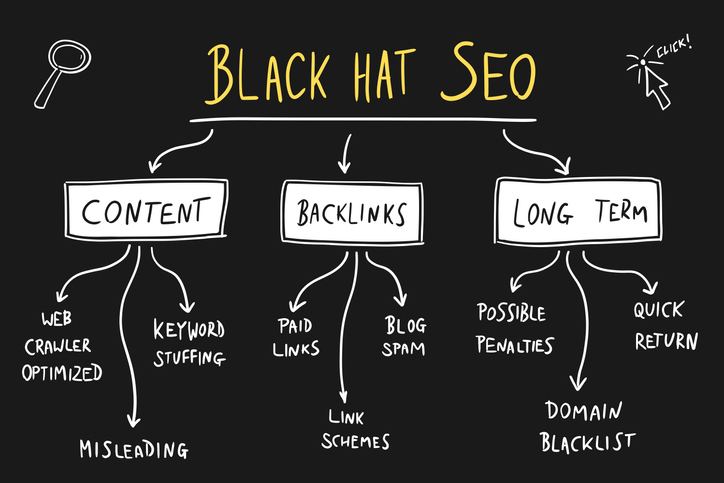Have you ever googled something and clicked on the first option only to realize that it doesn’t make sense at all? It feels all over the place and doesn’t seem to offer any real context? Those sites probably use black hat SEO techniques for their blogs instead of ethical on-page SEO techniques.
Black Hat SEO is Unethical

Black Hat SEO is a practice used to increase a site’s rank in search engines using means that violate the search engine’s terms of service. Those who participate in black hat SEO include computer hackers, virus creators, and those who perform unethical actions online. These disapproved practices can result in a site being banned from the search engine and its affiliated sites.
4 Black Hat SEO Techniques and Why We Don’t Use Them
- Keyword Stuffing
- Spam Comments
- Cloaking
- Clickbait
Technique #1. The Truth About Keyword Stuffing
The use of keywords is vital for the success of your site and a successful on-page SEO tactic. Keyword stuffing is the excessive use of keywords and their synonyms in the content of your website. It is easy to locate keyword stuffing because you will see the words that don’t make any sense or appear unnatural on the page.
We avoid this black hat SEO technique because we want readers to continue to visit our clients’ sites and ours. Using our on-page SEO techniques helps us do this and succeed.
Technique #2. Moderate Your Comments

Have you ever read an article and seen numerous comments promoting a site that has nothing to do with the article itself? These are spam comments and are generally posted on random blogs with no correlation to the actual article to generate traffic to the link. Unfortunately, this black hat SEO technique is common and can be found virtually anywhere on the internet.
We don’t do this because we want our readers to trust our content. Using this type of tactic can hurt on-page SEO success. However, it is important to moderate your comments to ensure spam comments aren’t being posted.
Technique #3. Cloaking Will Get You Banned
Cloaking is a technique where you display one type of content to the users visiting your site but show a completely different type of content to the search engines. Cloaking is purposefully misleading to users and a poor technique.
We avoid this black hat SEO practice because not only will we lose our users due to false tactics, but we can get banned from search engines and therefore hurt the success we worked hard to build.
Instead, on-page SEO techniques enhance the user experience of your visitors by providing them with quality content that doesn’t deceive them.
Technique #4. Misleading Clickbait Practices
We have all been there before. An attractive header catches your eye, and you are excited to click on it! However, once you click on it, you realize that the content you were expecting to see doesn’t exist. This black hat SEO technique can drive up click rates initially, but once the user realizes they were tricked, they most likely won’t return.
On-page SEO teaches us that while headers are essential to gain users, the content with the header is just as essential to retain a reader. Therefore, we focus on our on-page SEO techniques and do not take shortcuts that aren’t sustainable for long-term success.
On-Page SEO vs. Black Hat SEO

There are so many different black hat SEO tactics that are used every day. Black hat SEO is not illegal, but it does violate the guidelines put in place by search engines and will be subject to a penalty as punishment.
While some companies or people do not mind using deceiving tactics, most brands choose to follow good on-page SEO techniques to ensure long-term success. On-page SEO comes from organic growth and following proper search engine-approved strategies.
